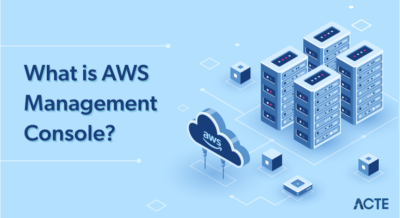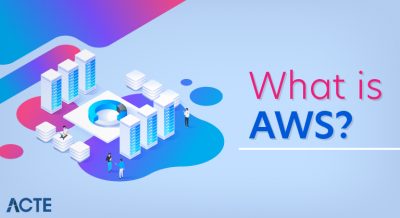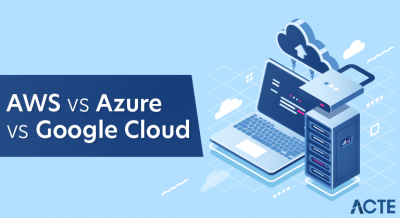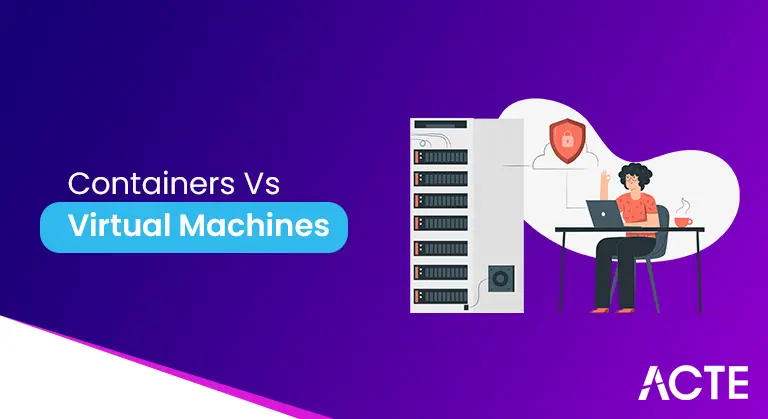
Introduction:
Container and VMs are fundamentally the same as asset virtualization advances. Virtualization is the cycle where a framework solitary asset like RAM, CPU, Disk, or Networking can be ‘virtualized’ and addressed as various assets. The vital differentiator among compartments and VMs is that VMs virtualize a whole machine down to the equipment layers and Containers just virtualize programming layers over the working framework level.
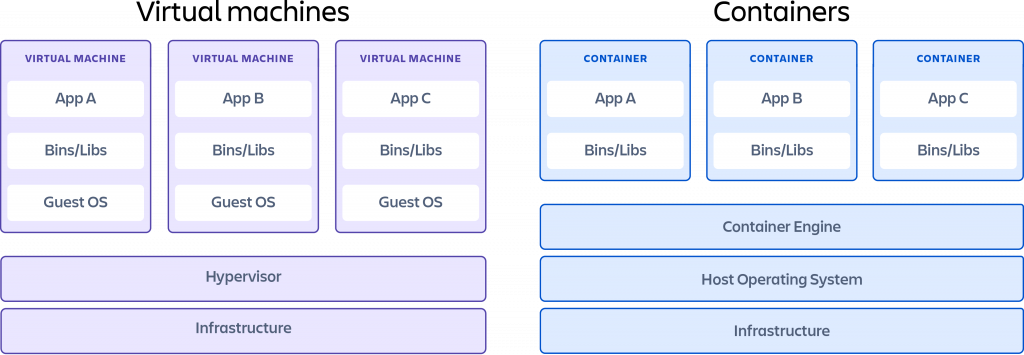
What is a Container?
Compartments are lightweight programming bundles that contain every one of the conditions needed to execute the contained programming application. These conditions incorporate things like framework libraries, outer outsider code bundles, and other working framework level applications. The conditions remembered for a Container exist in stack levels that are higher than the working framework.
Pros
- Since compartments are lightweight and just incorporate undeniable level programming, they are extremely quick to change and emphasize on. Powerful Ecosystem.
- Most Container runtime frameworks offer a facilitated public vault of pre-made compartments. These Container vaults contain numerous famous programming applications like information bases or informing frameworks and can be immediately downloaded and executed, saving time for improvement groups.
Emphasis speed
Cons
- Containers all offer a similar basic equipment framework beneath the working framework layer, it is conceivable that an adventure in one compartment could break out of the Container and influence the common equipment.
- Most well known compartment run-times have public storehouses of pre-constructed Containers. There is a security hazard in involving one of these public pictures as they might contain takes advantage of or might be powerless against being seized by terrible entertainers.
Shared host takes advantage
Well known Container suppliers
Docker
Docker is the most famous and broadly utilized compartment runtime. Docker Hub is a monster public vault of famous containerized programming applications. Compartments on Docker Hub can in a flash downloaded and conveyed to a nearby Docker runtime.
RKT
Articulated “Rocket” RKT is a security previously engaged Container framework. Rkt Containers don’t permit shaky compartment usefulness except if the client unequivocally empowers unreliable elements. RKT Containers plan to address the basic cross tainting exploitive security gives that other compartment runtime frameworks experience the ill effects.
Linux Containers – LXC
LXC is one part of an open source linux compartment runtime framework. LXC is utilized to confine working framework level cycles from one another. Docker really utilizes LXC in the background. Linux Containers plan to offer a merchant impartial open source Container runtime.
CRI-O
CRI-O is an arising open source compartment runtime standard that is being created in cooperation by numerous endeavor organizations. The CRI-0 detail is upgraded for the Kubernetes Container the board framework.
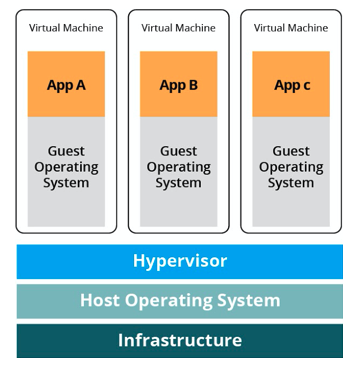
What is a VM?
VMs are weighty programming bundles that give total imitating of low level equipment gadgets like CPU, Disk and Networking gadgets. VMs may likewise incorporate a correlative programming stack to run on the imitated equipment. These equipment and programming bundles consolidated produce a completely utilitarian depiction of a computational framework.
Aces of Virtual Machines(VM)
Full Isolation security
VMs run in Isolation as a completely independent framework. This implies that VM’s are safe to any adventures or obstruction from other VMS on a common host. An individual VM can in any case be captured by an adventure however the took advantage of VM will be secluded and unfit to sully some other adjoining VMs.
Intelligent Development
Compartments are generally static meanings of the normal conditions and design expected to run the Container. VMs are more unique and can be intuitively evolved. When the fundamental equipment definition is indicated for a VM the VM can then be treated as a stripped down PC. Programming can physically be introduced to the VM and the VM can be snapshotted to catch the current arrangement state. The VM depictions can be utilized to reestablish the VM to that moment or twist up extra VM’s with that design.
Cons
Emphasis speed
VMs are tedious to construct and recover in light of the fact that they include a full stack framework. Any alterations to a VM depiction can invest in some opportunity to recover and approve they act true to form.
Capacity size cost
VMs can take up a ton of extra room. They can rapidly develop to a few Gigabytes in size. This can prompt circle space deficiency issues on the VMs have machine.
Famous VM suppliers
Virtualbox
Virtualbox is a free and open source x86 engineering imitating framework claimed by Oracle. Virtualbox is one of the most well known and set up VM stages with an environment of strengthening apparatuses to help create and convey VM pictures.
VMware
VMware is a public corporation that has assembled its business on one of the first x86 equipment virtualization advancements. VMware comes included with a hypervisor which is a utility that will send and deal with different VMs. VMware has hearty UI for overseeing VMs. VMware is an incredible endeavor VM choice contribution support.
QEMU
QEUM is the most powerful equipment imitating VM choice. It has support for any conventional equipment engineering. QEMU is an order line just utility and doesn’t offer a graphical UI for design or execution. This compromise makes QEMU one of the quickest VM choices.
Which choice is better for you?
Assuming that you have explicit equipment necessities for your undertaking, or you are creating on one equipment stage and need to focus on another like Windows versus MacOS, you should utilize a VM. Most other ‘programming no one but’ prerequisites can be met by utilizing compartments.
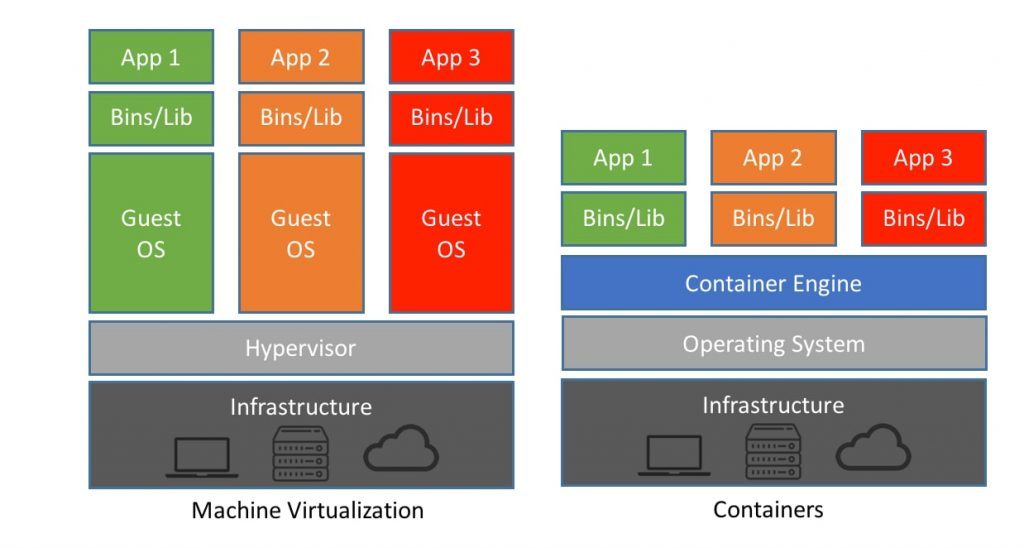
How might you utilize Containers and VMs together?
It is far from impossible to involve Containers and VM as one albeit the viable use-cases might be restricted. A VM can be made that copies an interesting equipment arrangement. A working framework can then be introduced inside this current VM’s equipment. When the VM is useful and boots the working framework, a compartment runtime can be introduced on the working framework. Now we have a utilitarian computational framework with copied equipment that we can introduce Containers on.
One pragmatic use for this design is trial and error for framework on chip arrangements. Well known framework on chip computational gadgets like The RaspberryPi, or BeagleBone improvement sheets can be imitated as a VM, to explore different avenues regarding running compartments on them prior to testing on the genuine equipment.
Yet, most of the time, your necessities will probably be met by one of the two. The way to choosing compartments or VMs for your virtualization needs is understanding your asset needs and the compromises you’re willing to make.
How virtualization functions?
Virtualization is an interaction by which programming is utilized to make a deliberation layer over PC equipment that permits the equipment components of a solitary PC to be partitioned into numerous virtual PCs.
The product utilized is known as a hypervisor — a little layer that empowers numerous working frameworks to run close by one another, having similar actual processing assets. When a hypervisor is utilized on an actual PC or server (otherwise called uncovered metal server) in a server farm, it permits the actual PC to isolate its working framework and applications from its equipment. Then, at that point, it can partition itself into a few autonomous “virtual machines.”
What are virtual machines?
- Virtual machines (VMs) are an innovation for building virtualized processing conditions. They have been around for a long time and are viewed as the reinforcement of the original of distributed computing.
- Basically, a virtual machine is a copying of an actual PC. VMs empower groups to run what seem, by all accounts, to be different machines, with numerous working frameworks, on a solitary PC. VMs associate with actual PCs by utilizing lightweight programming layers called hypervisors. Hypervisors can isolate VMs from each other and dispense processors, memory, and capacity among them.
- VMs are otherwise called virtual servers, virtual server occasions and virtual private servers.
Features with Containers?
- Compartments are a lighter-weight, more nimble method of taking care of virtualization — since they don’t utilize a hypervisor, you can appreciate quicker asset provisioning and speedier accessibility of new applications.
- Instead of turning up a whole virtual machine, containerization bundles together everything expected to run a solitary application or microservice (alongside runtime libraries they need to run). The Container incorporates all the code, its conditions and surprisingly the working framework itself. This empowers applications to run anyplace — a PC, a conventional IT framework or the cloud.
- Containers utilize a type of working framework (OS) virtualization. Set forth plainly, they influence elements of the host working framework to confine cycles and control the cycles’ admittance to CPUs, memory and work area space.
- Containers have been around for quite a long time, yet the normal agreement is that the advanced compartment time started in 2013 with the presentation of Docker, an open source stage for building, conveying and overseeing containerized applications. Look into Docker, Docker compartments, Dockerfiles (the Container picture’s construct document) and how the biological system has developed with Container innovation throughout the last decade.
Containers versus VMs: What are the distinctions?
In customary virtualization, a hypervisor virtualizes actual equipment. The outcome is that each virtual machine contains a visitor OS, a virtual duplicate of the equipment that the OS needs to run and an application and its related libraries and conditions. VMs with various working frameworks can be run on a similar actual server. For instance, a VMware VM can run close to a Linux VM, which runs close to a Microsoft VM, and so forth.
Conclusion:
Because Docker containers share many of their resources with the host system, they require fewer things to be installed in order to run. Compared to a virtual machine, a container typically takes up less space and consumes less RAM and CPU time.

